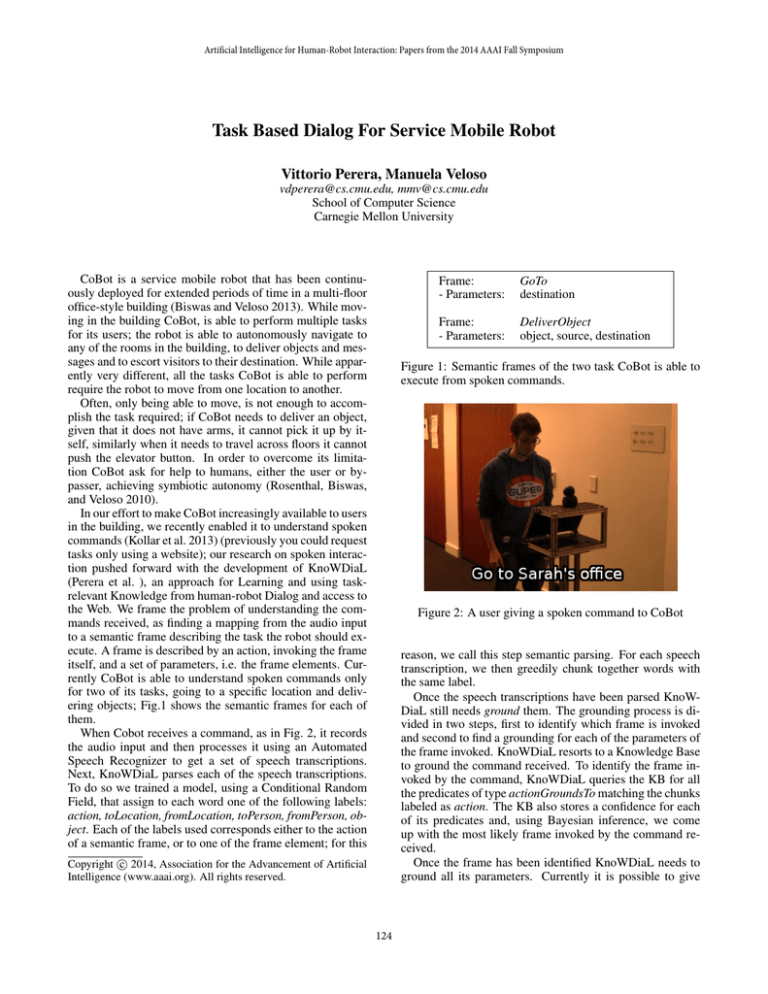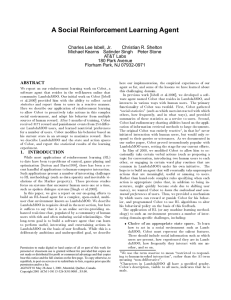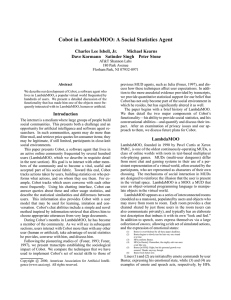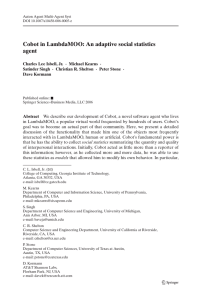
Artificial Intelligence for Human-Robot Interaction: Papers from the 2014 AAAI Fall Symposium
Task Based Dialog For Service Mobile Robot
Vittorio Perera, Manuela Veloso
vdperera@cs.cmu.edu, mmv@cs.cmu.edu
School of Computer Science
Carnegie Mellon University
CoBot is a service mobile robot that has been continuously deployed for extended periods of time in a multi-floor
office-style building (Biswas and Veloso 2013). While moving in the building CoBot, is able to perform multiple tasks
for its users; the robot is able to autonomously navigate to
any of the rooms in the building, to deliver objects and messages and to escort visitors to their destination. While apparently very different, all the tasks CoBot is able to perform
require the robot to move from one location to another.
Often, only being able to move, is not enough to accomplish the task required; if CoBot needs to deliver an object,
given that it does not have arms, it cannot pick it up by itself, similarly when it needs to travel across floors it cannot
push the elevator button. In order to overcome its limitation CoBot ask for help to humans, either the user or bypasser, achieving symbiotic autonomy (Rosenthal, Biswas,
and Veloso 2010).
In our effort to make CoBot increasingly available to users
in the building, we recently enabled it to understand spoken
commands (Kollar et al. 2013) (previously you could request
tasks only using a website); our research on spoken interaction pushed forward with the development of KnoWDiaL
(Perera et al. ), an approach for Learning and using taskrelevant Knowledge from human-robot Dialog and access to
the Web. We frame the problem of understanding the commands received, as finding a mapping from the audio input
to a semantic frame describing the task the robot should execute. A frame is described by an action, invoking the frame
itself, and a set of parameters, i.e. the frame elements. Currently CoBot is able to understand spoken commands only
for two of its tasks, going to a specific location and delivering objects; Fig.1 shows the semantic frames for each of
them.
When Cobot receives a command, as in Fig. 2, it records
the audio input and then processes it using an Automated
Speech Recognizer to get a set of speech transcriptions.
Next, KnoWDiaL parses each of the speech transcriptions.
To do so we trained a model, using a Conditional Random
Field, that assign to each word one of the following labels:
action, toLocation, fromLocation, toPerson, fromPerson, object. Each of the labels used corresponds either to the action
of a semantic frame, or to one of the frame element; for this
Frame:
- Parameters:
GoTo
destination
Frame:
- Parameters:
DeliverObject
object, source, destination
Figure 1: Semantic frames of the two task CoBot is able to
execute from spoken commands.
Figure 2: A user giving a spoken command to CoBot
reason, we call this step semantic parsing. For each speech
transcription, we then greedily chunk together words with
the same label.
Once the speech transcriptions have been parsed KnoWDiaL still needs ground them. The grounding process is divided in two steps, first to identify which frame is invoked
and second to find a grounding for each of the parameters of
the frame invoked. KnoWDiaL resorts to a Knowledge Base
to ground the command received. To identify the frame invoked by the command, KnoWDiaL queries the KB for all
the predicates of type actionGroundsTo matching the chunks
labeled as action. The KB also stores a confidence for each
of its predicates and, using Bayesian inference, we come
up with the most likely frame invoked by the command received.
Once the frame has been identified KnoWDiaL needs to
ground all its parameters. Currently it is possible to give
c 2014, Association for the Advancement of Artificial
Copyright Intelligence (www.aaai.org). All rights reserved.
124
• Type of interaction: A symbiotic autonomous service
robot interacts with different types of humans, namely
four types: (i) the task requester, (ii) the task recipient,
(iii) the potential helpers (press elevator buttons, put coffee in basket), and (iv) the random bystanders who are
not related to the task. The human-robot interaction needs
then to be well aware of the different type of humans, and
a question remains on how to adapt and adjust the interaction with each human.
• Delivering messages: The basic speech interface lets the
robot understand commands relating to two tasks. We
would like to extend this interface to all the tasks CoBot
is currently able to perform. In particular we are interested in having our robot delivering messages in a natural way. For instance if Vittorio asks CoBot “Please tell
Manuela I will be late for our meeting”, once the robot
gets to Manuela’s office, it should report the message as
“Vittorio said he will be late for your meeting” rather than
simply repeating the message received.
• Asking unrelated questions: Currently CoBot asks
questions only when it is not able to ground part of the
command received. We can imagine the robot also asking
questions not directly related to the command received,
which leads to two different problems: (i) what information is useful to a robot and should it ask about? (ii) when
is it ok to ask questions that do not relate to the command
received?
• Social interactions: As of now, we assume all the speech
directed to the robot is asking it to perform a task. Unfortunately users, especially inexperienced ones, have very
high expectations for robots, and will ask them all sorts
of things. We should be able to reliably distinguish what
refers to a command and what does not; moreover, if the
speech received does not refer to a command, we need to
design appropriate ways to handle it.
In conclusion, we have enabled our service mobile robot,
CoBot, to understand spoken commands. The approach used
proved to be effective, but it also opened new research paths
that we hope will contribute to increase our understanding
on how to handle a interaction between the user and a service
mobile robot.
spoken commands to Cobot to execute two different tasks,
namely moving to a specific location (GoTo) and delivering
an object (DeliverObject). In order to ground the frame parameters, KnoWDiaL queries the Knowledge Base for predicates matching the labels returned by the parser. For instance, if the action identified is GoTo and the parser returns
a chunk labeled as toLocation, the predicate queried will be
locationGroundsTo; similarly if the chunk returned by the
parser is labeled as toPerson, the predicate queried is personGroundsTo. Since all of the tasks CoBot can perform
involve moving from one location to another, the grounding for frame parameters are, in general, x, y coordinates
on its map, represented by four digit numbers associated
with rooms in the building. Once all the parameters have
been identified and correctly grounded, Cobot can execute
the command received.
Unfortunately the Knowledge Base does not always contain the information needed to identify the frame corresponding to the commands received or to ground all of its
parameters. CoBot then explicitly asks for the element it’s
missing; for instance, if the command received refers to the
GoTo task but it was not possible to ground the destination,
the robot will ask “Where should I go? Please give me a four
digit room number.”
Once the user answers all the question needed to ground
the command, the robot has all the information to execute
it. Before starting to move, the robot asks one more confirmation question and then starts executing the command
received. Asking a confirmation question lets the user make
sure the command was properly understood but also gives
KnoWDiaL the opportunity to updated its Knowledge Base
with new facts learned by asking explicit questions about the
missing parameters.
The approach described above is effective in enabling
CoBot to understand spoken commands but it also opens up
many questions that we are currently addressing. Hereafter
is a list, together with a short description, of ongoing research on CoBot and its interaction with users.
• Confirmation request: We clearly would like a robot to
go to the correct location corresponding to the user request. However, given that the robot is processing speech
with inevitable noise, and that the robot is using a knowledge base learned from interactions with humans, who
may have or not been correct, it remains a question to
decide when the robot should ask for confirmation about
its eventual grounding choices.
References
Biswas, J., and Veloso, M. M. 2013. Localization and navigation of
the cobots over long-term deployments. The International Journal
of Robotics Research 32(14):1679–1694.
Kollar, T.; Perera, V.; Nardi, D.; and Veloso, M. 2013. Learning
environmental knowledge from task-based human-robot dialog. In
Robotics and Automation (ICRA), 2013 IEEE International Conference on, 4304–4309. IEEE.
Perera, V.; Soetens, R.; Kollar, T.; Samadi, M.; Sun, Y.; Nardi, D.;
Van De Molengraft, R.; and Veloso, M. Learning task knowledge
from dialog and web access. In preparation for submission.
Rosenthal, S.; Biswas, J.; and Veloso, M. 2010. An effective
personal mobile robot agent through symbiotic human-robot interaction. In Proceedings of the 9th International Conference on
Autonomous Agents and Multiagent Systems: volume 1-Volume 1,
915–922. International Foundation for Autonomous Agents and
Multiagent Systems.
• Task explanation: The outcome of the interaction with
the human is the specification of a task that the robot then
plans to accomplish. As such planning will involve the
consideration of different routes, possibly times and coordination with other tasks, it remains a question to decide
how much of such planning process should the robot inform the user about. This question is also particularly relevant if the request was complex with conjunctions, disjunctions, and conditionals, which the autonomous robot
then plans according to its own task optimization criteria,
which may or may not need to be explained or communicated to the human.
125






